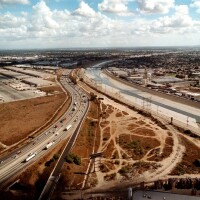L.A. River Improvement District Encourages River-Embracing Development

After a seven year saga of community outreach, approvals and clarifications, the proposed River Improvement Overlay District (RIO), and a more geographically specific Los Angeles River Improvement Overlay Zone (LA-RIO) is now a reality. Mayor Eric Garcetti approved the two ordinances July 8, after it passed City Council early in July. The ordinances will now apply to new developments seeking permits starting August 20.
"More than just passing regulations, these ordinances really give communities a chance to celebrate their being near the river, to say that they are part of this Los Angeles River ecosystem," said Claire Bowin, City Planner for Los Angeles. According to Bowin, being part of an acknowledged River District could also be beneficial for the neighborhoods participating because it allows them to work with the city and apply for grants that improve their river-adjacent communities.
As we previously reported, the RIO ordinance creates a general supplemental use district that specifically meant for properties adjacent to waterways. The idea was to incorporate the principles outlined in the Los Angeles River Master plan into reality, by codifying the rules and regulations for land development along the waterway. The LA-RIO ordinance creates a specific geographical area that encompasses property within 2,500 feet (or half a mile) of the 32-mile Los Angeles River in the city's limits. The regulations address landscaping, screening and fencing, lighting, and orientation, on new developments by the Los Angeles River.
Though the ordinances take effect August 20, residents won't be seeing changes anytime soon. Developments that have already gained approved permits are exempt from the new regulations within the LA-RIO district, so any designs already under construction, by the likes of the 56-unit LA River Lofts on Gleneden Street, or 50-unit Rio Vista Apartment affordable housing, will not be affected. Landscape architect Glen Dake of DakeLuna said, "Typically, ordinances like this have no bearing on ongoing projects like the River Lofts. Once you have an approved permit, you are approved throughout the whole construction process unless there are major changes in your design." He consulted for developers Anastasi Construction at the beginning of the River Lofts project eight years ago, even before the planning for RIO and LA-RIO began.

The ordinance will not immediately affect ongoing development, but future projects will be subject to the changes, which Robert de Forest thinks can only mean good news for the neighborhood. De Forest is the principal of real estate investment company The Pinyon Group, whose Terra River LLC partnership is launching a river-related project in Elysian Valley in the near future. De Forest has already purchased seven separate parcels of land in the neighborhood, totaling more than an acre, which he hopes to transform into several mixed-use, mixed-income, live-work environments that acknowledges the river as an asset.
"Our commitment to the river really brought us here. The RIO doesn't really affect our plans because we will end up doing those things anyway. Our goal is to be the first truly river-embracing development in the city," says de Forest.
Not all developers working in the neighborhood might feel the same way he does. Pushed out of an increasingly built city, some developers have turned to river-adjacent neighborhoods in the hopes of making a profit, while not necessarily considering the area's existing cultural fabric.
"The irony is that because of all the press the river has gotten lately, it's brought developers in who might not yet have that river sense," says de Forest. "If the RIO and LA-RIO gives them a framework to develop that, then much the better."
Ultimately, only after years of adoption will the city see the fruits of these ordinances, which gives some residents cause for concern.
Mott Smith of real estate development firm Civic Enterprise adds, "The RIO looks well-constructed and common-sensical. That said, it's still just zoning. It's not a plan for public City projects like parks, roads and sidewalks -- what we really need to complement River investment. It's just guidance for whatever private projects may or may not happen down the road."
The ordinance would add another layer of clearance from City Planning, apart from the requirements from the Department of Building and Safety. If anything, it adds an extra step to an approval process that no one enjoys.
Though not yet a proven tool, RIO and LA-RIO could become the foundation for productive, holistic development along the river, according to Omar Brownson, Executive Director of the Los Angeles River Revitalization Corporation. "RIO and LA-RIO is a mechanism to think about the river community on the day-to-day level, but on the whole at the same time. It supports the creation of a community that connects to the river," he says. "What the LA-RIO looks like, no one knows yet, but it does provide the basis to start substantive conversations."


